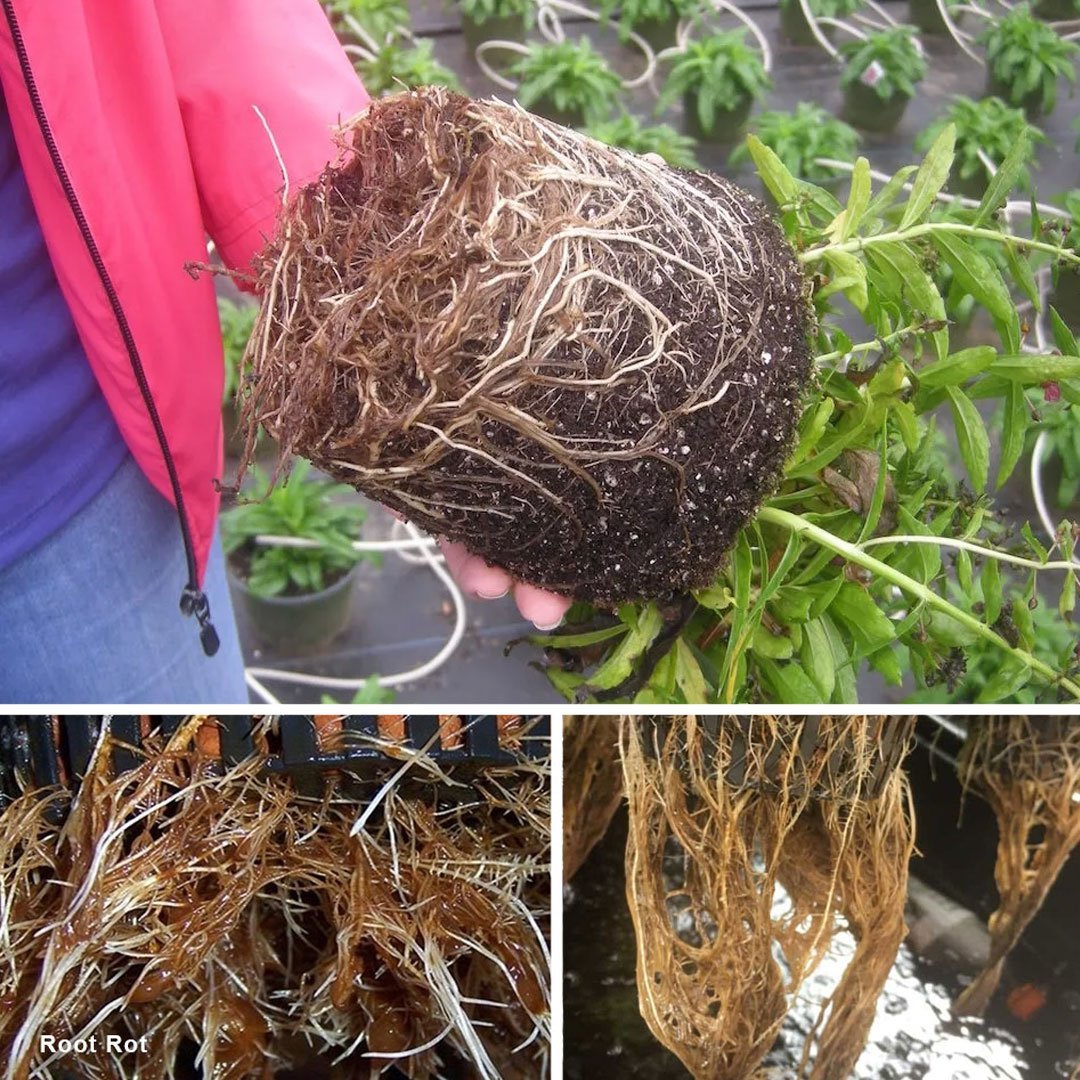Cannabis root rot symptoms, prevention & cure

Cannabis root rot is a common plant disease caused by fungal or bacterial pathogens like Pythium, Fusarium, or Phytophthora, which attack the root system. This weakens nutrient uptake, leading to wilting and potentially fatal plant issues if untreated. Thriving in wet, poorly aerated environments, cannabis root rot affects feminised seed and autoflower seed varieties equally.
Read on for:
- A comprehensive guide covering symptoms, causes, prevention and cures for cannabis root rot.
- Practical advice for both soil root rot and DWC root rot. DWC, Deep Water Culture, is a type of hydroponic grow system.
- Practical, expert-backed tips to prevent and treat root rot effectively.
- Pictures to help you identify root rot at various stages of progression.
- Answers to the most common growers FAQs, backed up by Dutch Passion’s decades of expertise in cannabis cultivation and home growing.
-
What are the main causes of cannabis root rot?
Soil root rot, aka cannabis root rot, is primarily caused by environmental factors that create favourable conditions for pathogens to survive and multiply. It can equally affect plants grown from cannabis seed or from cuttings. The main causes include:
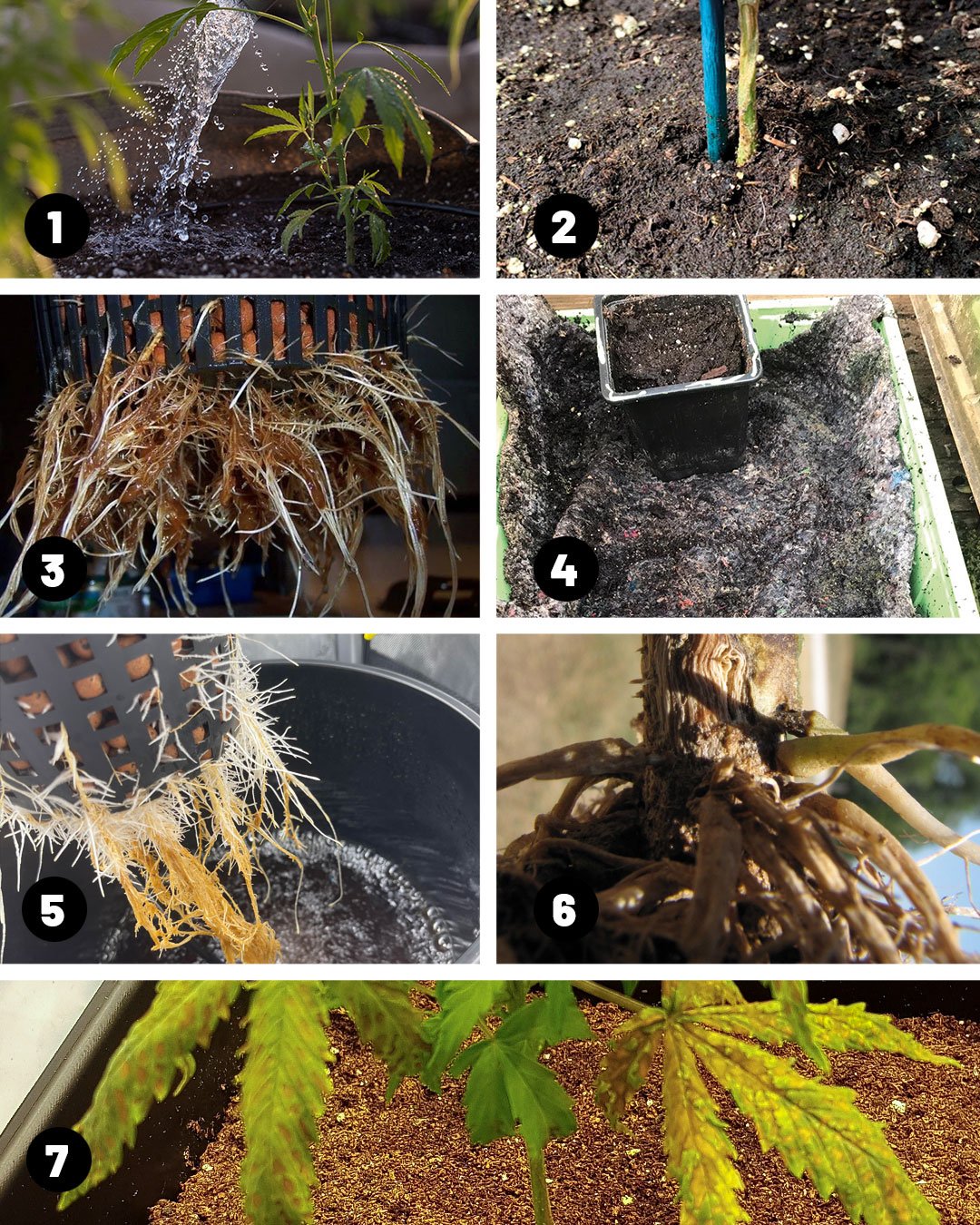
1) Overwatering (Soil): Excess water in soil leads to oxygen deprivation, weakening roots and allowing pathogens like Pythium to thrive.
2) Poor drainage (Soil): Compacted or poorly draining soil traps moisture, creating a breeding ground for fungi.3
3) High humidity/waterlogged conditions (DWC): In DWC systems, stagnant or overly warm water (above 72°F/22°C) promotes pathogen growth.
4) Contaminated equipment or contaminated grow medium: Reusing unsterilised pots, tools, or hydroponic reservoirs can introduce pathogens.
5) Inadequate aeration (DWC): Low oxygen levels in the nutrient solution weaken roots and encourage bacterial or fungal growth.
6) Root Damage: Physical damage from transplanting or pests can make roots susceptible to infection.
7) Nutrient Imbalances: Over-fertilisation or pH imbalances (outside 5.5–6.5 for hydro stress roots, increasing vulnerability to pathogen infection.
How to identify cannabis root rot
Identifying root rot early is critical to saving affected plants. Symptoms vary by stage and growing medium (e.g. soil vs. DWC).
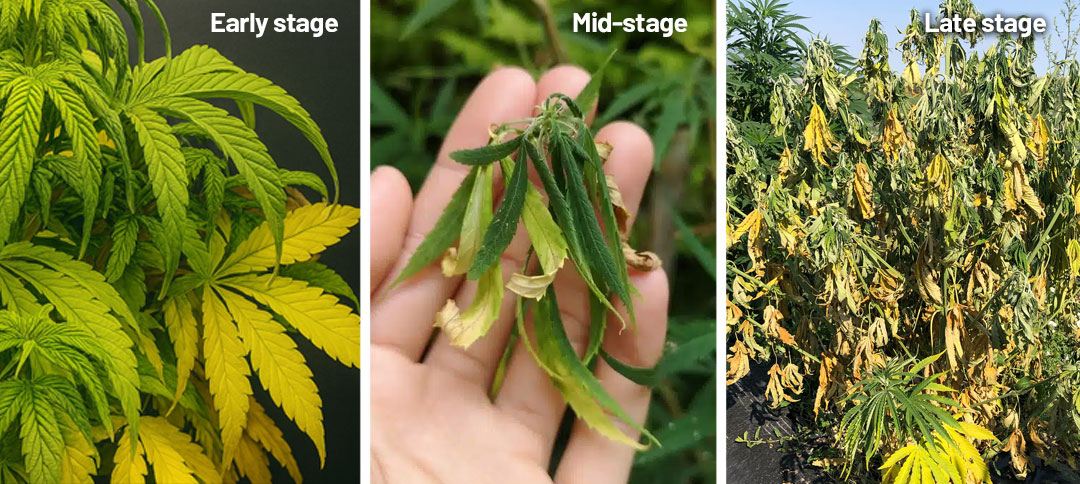
How to identify root rot when growing cannabis in soil
| Early stage | Plant symptoms: Leaves begin to pale or yellow slightly, especially the lower ones. They may droop even though the soil feels moist. Plants can appear a bit smaller or growing slower than usual. Root appearance: Roots are mostly white and firm, but you may notice the tips starting to turn light brown or feel slightly slimy. |
| Mid-stage | Plant symptoms: Yellowing or browning spreads through the foliage. Wilting becomes constant, even after watering. Growth noticeably slows or stops. Root appearance: Roots lose their firmness and become soft or stringy. When handled, some roots may break apart easily. |
| Late stage | Plant symptoms: The plant wilts severely, leaves fall off, and stems may feel soft or weak at the base. White fungal growth might appear on or near the stem. The plant is close to dying. Root appearance: Most roots are dark brown or black, coated in slime, breaking apart easily, and emit a strong, unpleasant odour. |
How to identify root rot when growing cannabis in deep water culture
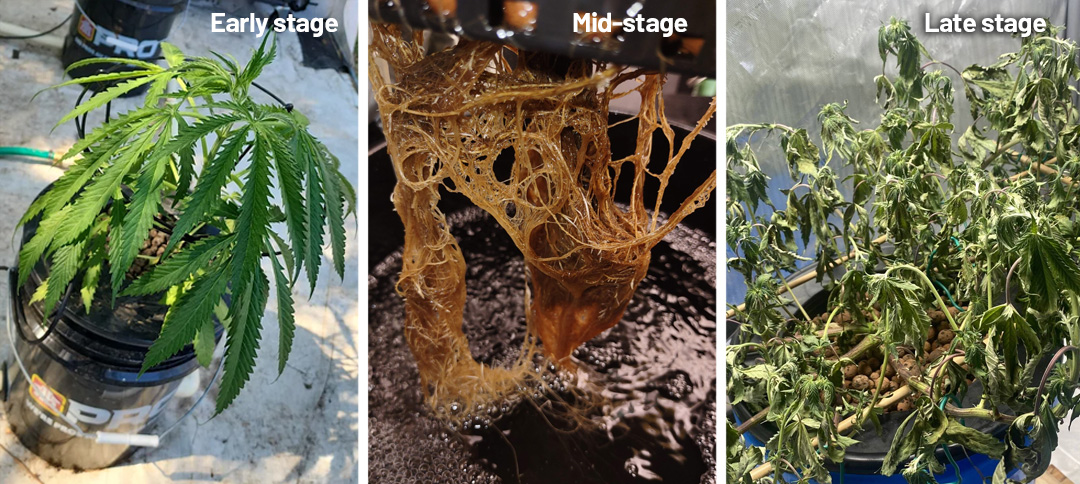
| Early stage | Plant symptoms: Leaves may droop slightly or appear less vibrant, even though nutrient levels seem correct. Growth slows unexpectedly. Root appearance: Healthy roots are bright white, but early rot causes a light brown or tan tint at the tips and a faint slimy coating. |
| Mid-stage | Plant symptoms: Wilting becomes more visible. Roots darken to brown or black, and a noticeable foul odour develops. Plants start showing nutrient deficiencies, such as yellowing or spotting, because the roots can’t absorb nutrients effectively. Root appearance: Roots are soft, sticky, or stringy and may tear apart easily when lifted from the water. |
| Late stage | Plant symptoms: Severe wilting, leaf loss, and collapsing stems are common. The lower stem may turn mushy or show patches of white fungus. The plant is often beyond recovery. Root appearance: Roots appear dark brown to black, covered in thick slime, disintegrating on touch, and producing a strong rotten smell. |
Cannabis root rot: autoflower seeds vs feminised seeds
When growing feminised seed varieties, root rot in veg does at least allow the plant time to continue veg and regain root healthy mass and growth before bloom.
However, autoflower seed varieties get no break in their biological clock. Time lost to cannabis root rot, or the treatments (e.g. root pruning/clipping) is time that simply can’t be regained. Harvest size and quality is inevitably affected if growing autoflower seeds and you are hit with an outbreak of root rot.
Cannabis root rot pictures
- Healthy Roots: White, firm and fibrous roots.
- Early Root Rot: Slightly discoloured (tan/brown) roots with minimal sliminess.
- Advanced Root Rot: Dark, slimy and decayed roots showing clear damage.
How to cure cannabis root rot
Curing cannabis root rot depends on the growing medium and the severity of the infection. In severe cases your plant may be beyond salvation. In less severe cases, your yield and harvest quality may be compromised. Below are tailored approaches for soil and DWC systems.
The Dutch Passion collection of grow guides and grow reports is a useful bookmark with extensive information for home growers about optimising conditions, environment, different cannabis seed types and much more.
Soil cannabis root rot
1) Stop Watering: Allow the soil to dry out completely to reduce moisture levels and starve pathogens.
2) Remove Affected Roots:
- Gently remove the plant from the soil and rinse roots to inspect.
- Use sterilised scissors (e.g. wiped with alcohol) to cut away brown, slimy, or mushy roots, leaving only healthy white roots.
- Soil root rot is a stressful experience which may take the plant a week or two to recover from. This is another reason why prevention is better than cure.
3) Treat with Beneficial Microbes. There are various products/options:
- Apply a microbial inoculant (e.g. Trichoderma or Bacillus subtilis) to combat pathogens and promote root health.
- Products with beneficial bacteria or blends of different types such as Bacillus amyloliquefaciens or mycorrhizal fungi
4) Repot in Fresh Grow Medium:
- Use well-draining soil (e.g., perlite or coco coir mix) and a clean pot.
- Ensure proper drainage to prevent recurrence.
5) Adjust Watering: Water sparingly, allowing the top inch of soil to dry out between waterings.
6) Use a soil moisture meter (tensiometer) to prevent overwatering. Overwatering is one of the most common errors, especially by less experienced growers. A soil moisture meter gives you precise info so you avoid over watering.
7) Colloidal silver and silver-stabilised hydrogen peroxide are sometimes used by soil growers for persistent fungal or bacterial infections. However silver and hydrogen peroxide can disrupt/prevent the vital work of beneficial bacteria in the soil and for that reason use of high levels of silver and Hydrogen Peroxide to prevent cannabis root rot is often an option of last (or later) resort.
DWC cannabis root rot
1) Drain and clean the entire system:
- Empty the reservoir and clean it thoroughly with a 10% hydrogen peroxide solution or dilute bleach to kill pathogens. Rinse everything thoroughly with water afterwards to avoid damaging your plants with bleach residues.
- Sterilise all equipment (air stones, tubing etc.).
2) Trim affected roots:
- Remove the plant and trim away slimy, discoloured roots with sterilised scissors. DWC root rot is messy business.
- Be cautious not to damage too much of the remaining healthy roots. Future plant growth will be stunted from the stress of root pruning. Adjust your harvest expectations accordingly.
3) Replace nutrient solution:
- Refill with fresh, pH-balanced nutrient solution at 20–22°C (68–72°F).
- Add products with beneficial bacteria to outcompete pathogens.
4) Increase oxygenation: Use a higher-capacity air pump and better air stone (or air-hose) to ensure adequate dissolved oxygen in the reservoir as well as ample bubbles for the roots to thrive in. This can also improve growth rates.
5) Monitor temperature: Keep water temperature below 22°C (72°F) to prevent pathogen growth. A nutrient cooling system is essential for growing during warmer months.
6) Specialist silver containing products give great results. These are colloidal silver and/or silver-stabilised hydrogen peroxide. In the latter case, silver ions help stabilise Hydrogen Peroxide for longer, allowing it to create hostile conditions for longer.
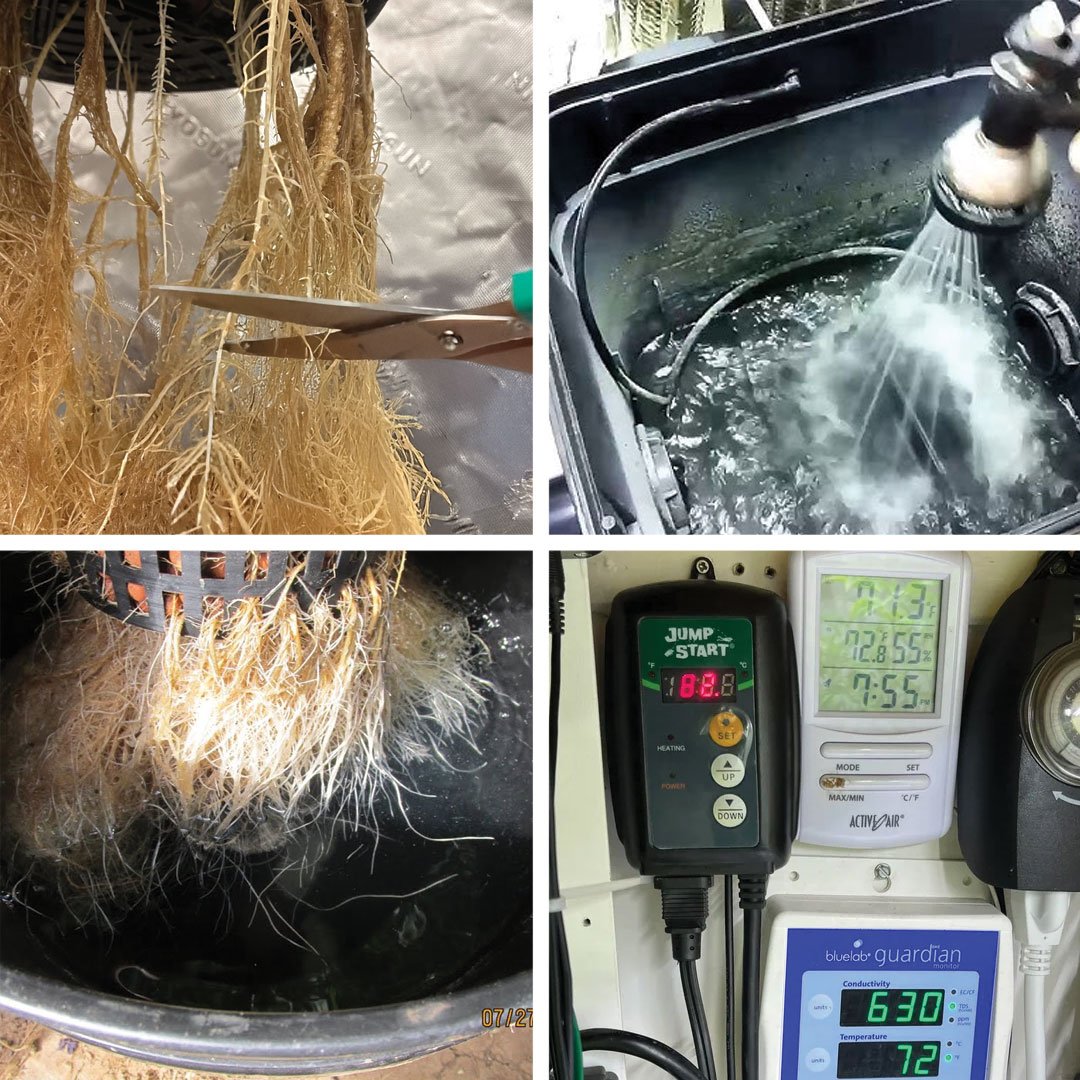
Key tip: If root rot is advanced with much of the root mass black and slimy, the plant may already be unsalvageable. Consider starting anew with preventive measures. And ensure you completely clean sterilise everything before your next grow. Germinate some fresh marijuana seeds and work hard to make sure you avoid the hassle of root rot in the future
Key expert tips to prevent cannabis root rot
Prevention is always better than cure. And one incidence of cannabis root rot can be sufficiently upsetting for the grower to invoke preventative measures to rule out future occurrences. Here are the most important tips for soil and DWC cannabis growers:
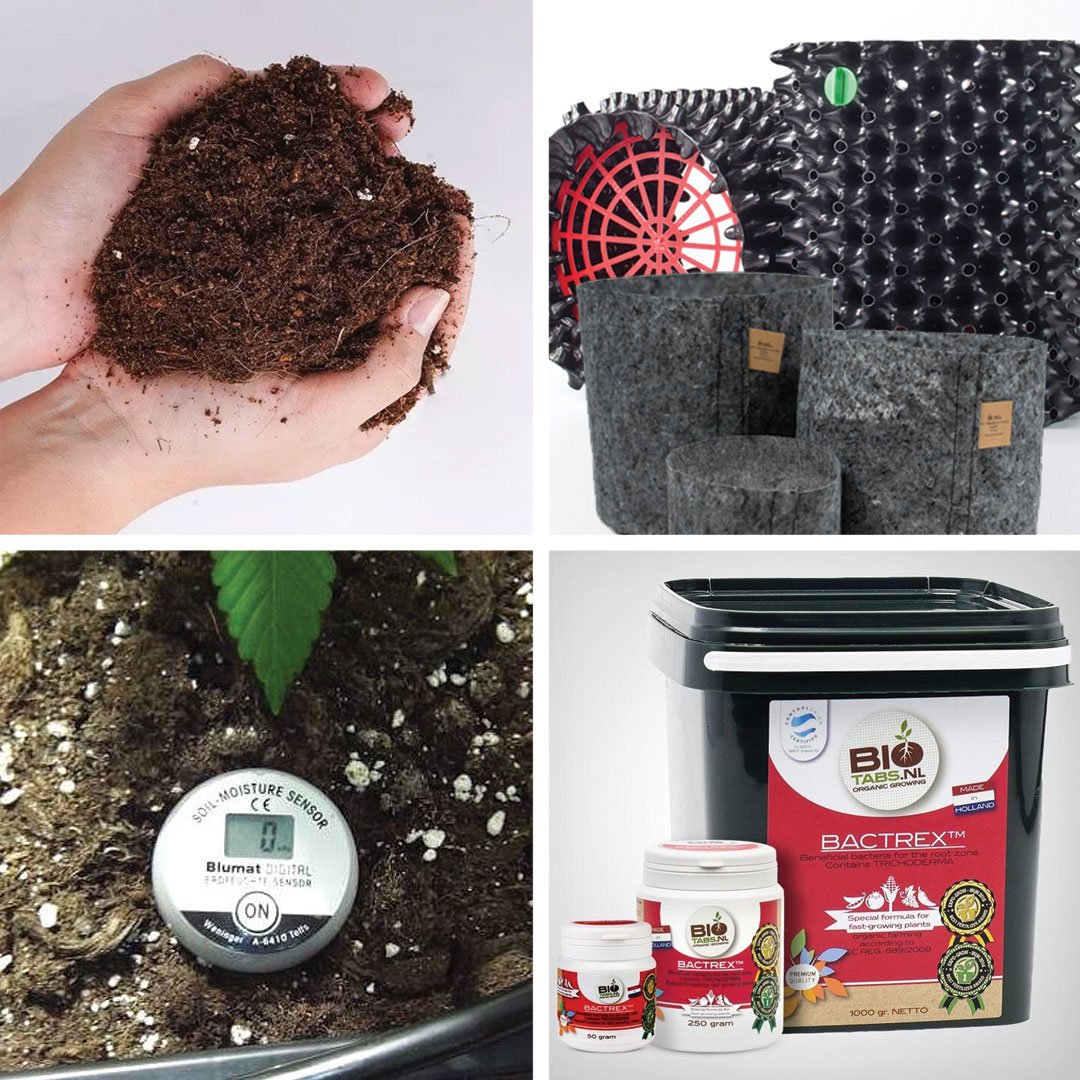
Soil
Use fast-draining Soil: Incorporate perlite, vermiculite, or coco coir to improve aeration and drainage.
Aerated containers FTW. If growing in soil consider air pot, felt sacks or other similarly highly-aerated grow containers, these allow high levels of root oxygenation.
Tensiometers remove the guesswork from watering. Use soil moisture meters (tensiometers) to ensure you are not over-watering. Pro growers use these to ensure accuracy with watering and avoid the rookie error of waterlogged roots.
Sterilise Equipment: Clean pots, tools and trays thoroughly before planting to eliminate pathogens. Hot soapy water to clean. 2-3% Hydrogen peroxide solution to sterilise.
Add Beneficial Microbes: Regularly apply Trichoderma or mycorrhizal fungi to boost root health and combat pathogens.
DWC
Monitor Water Temperature: Use a chiller to keep nutrient solution between 68–72°F (20–22°C). Trying to grow indoors with DWC without a chiller, especially in summer, is inviting potential trouble.
Ensure High Oxygen Levels: Invest in a powerful air pump and heavy-duty air stones to maximise dissolved oxygen and bubble generation. Many DWC growers report improved plant growth with higher volume air pumps. Sometimes budget DWC systems may come with underpowered air pumps. Don’t be afraid to upgrade to a more powerful pump.
Regular Cleaning: Clean reservoirs and equipment weekly to prevent pathogen buildup. The best DWC growers are obsessive about cleanliness & control.
Use Beneficial Bacteria: Take advantage of products that contain beneficial bacteria that colonise roots to outcompete pathogens like Pythium. This will enhance nutrient uptake and promote robust root growth.
Check pH Daily: Maintain nutrient solution pH (often a target value around pH 5.8-6.2) to prevent stress and pathogen growth.
Key Tip: Always quarantine new plants to prevent introducing pathogens to your grow space. Professional growers have very strict protocols for any new plants. These protocols have often been developed after costly disease outbreaks have decimated the grow rooms.
This 2022 paper from the University of Kentucky about disease management in hydroponic systems offers a well-written deeper dive for the hydro-pros.
Cannabis root rot FAQ
Can Root Rot Spread to Nearby Cannabis Plants?
Unfortunately yes, root rot can spread to nearby plants, especially in hydroponic systems like DWC where water is shared. Pathogens like Pythium can transfer through water, soil, or contaminated tools. To prevent spread:
- Isolate affected plants immediately.
- Sterilise all equipment and avoid cross-contamination.
- Find a way to isolate the plants from the common nutrient supply, if using e.g. a hydro shared reservoir system.
Can Pythium Go Away on Its Own?
Unfortunately not. Pythium (a common root rot pathogen) does not go away on its own. It thrives in wet, low-oxygen environments and requires active intervention (e.g., removing affected roots, adding beneficial microbes, or improving conditions) to eliminate it. Ignoring Pythium can lead to plant death.
When Is It Too Late to Cure Cannabis Root Rot?
It’s too late to cure root rot when:
- Most or all roots are black, slimy, and disintegrated.
- The plant shows severe wilting, stem rot, or complete leaf drop.
- The plant no longer responds to treatment (e.g., no new growth after 1–2 weeks). In such cases, it’s better to discard the plant and focus on preventing future infections.
How Long Does It Take to Cure Root Rot?
The time to cure root rot depends on the severity and growing medium:
Early Stage: With prompt action (trimming roots, adjusting conditions), recovery can begin within 3–7 days, with full recovery in 1–2 weeks.
Mid-Stage: Recovery may take 1–3 weeks if healthy roots remain and treatment is effective.
Late Stage: Recovery is unlikely, and plants may not survive despite treatment. Regular monitoring and maintenance are crucial to ensure the plant regains health.
Can silver be used to treat and prevent root rot?
Yes, and many hydroponics growers find Silver based products extremely effective at low dosages. However, some growers prefer not to use heavy metals in their grow room, even when there is limited evidence of danger at the low concentrations used. Here are the basics:
Colloidal Silver: A suspension of tiny silver particles (typically 5–50 ppm) in water. It acts as a broad-spectrum antimicrobial, penetrating root zones to kill pathogens by binding to their enzymes and DNA, preventing reproduction. In plants, Silver can also enhance nutrient uptake and stress resistance by improving trace element absorption.
Silver-Stabilised Hydrogen Peroxide products: Combines H₂O₂ (Hydrogen Peroxide which releases oxygen to aerate roots and oxidise pathogens) with silver ions for prolonged stability. The silver slows down H₂O₂ decomposition, extending its antimicrobial action in reservoirs or grow medium. This is particularly useful in hydro systems where rapid H₂O₂ degradation is common.
Cannabis root rot: a misery best avoided!
If caught early enough, root rot isn’t necessarily the end if your grow - though the after-effects of it may mean a smaller & perhaps lower quality harvest.
However, if left unattended root rot is a proven killer. Those that can maintain good grow room conditions & hygiene never see root rot. But one experience of it is normally sufficient motivation for a grower to update grow room methods to avoid a repeat riot of root rot.
If you’re planning a grow, check out the ongoing Dutch Passion seed sale where you will find some strains at half-price or better!





























